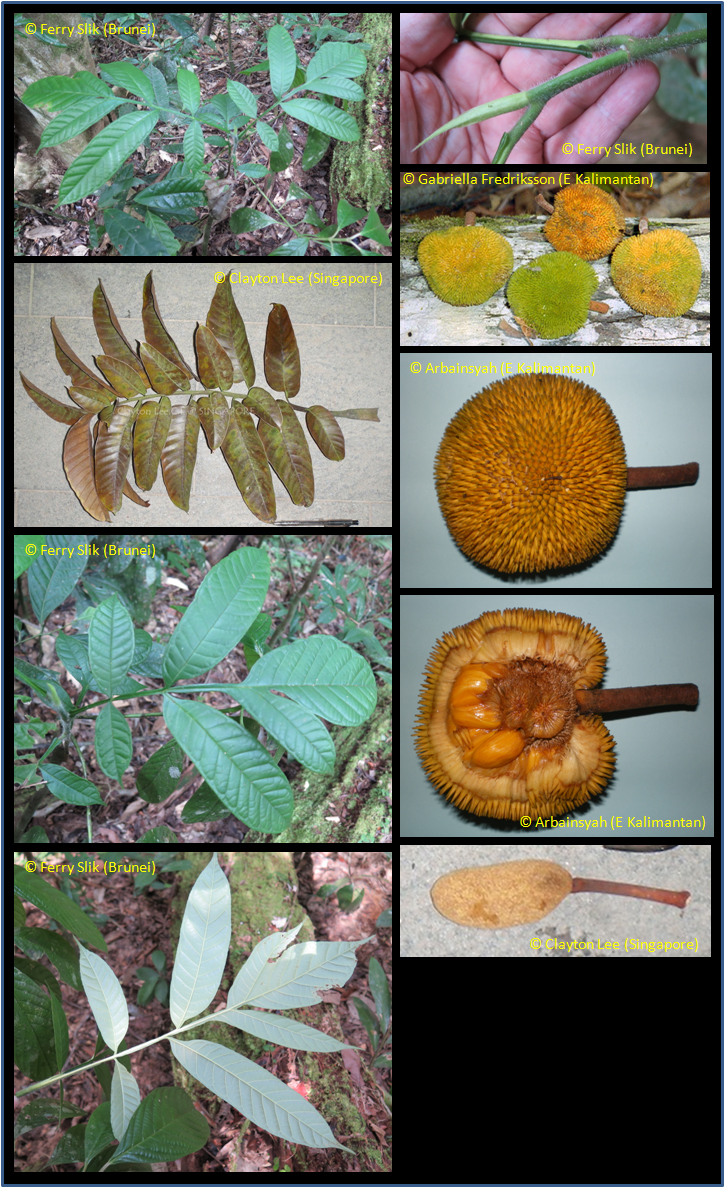Artocarpus anisophyllus Miq., Fl. Ned. Ind. Suppl. (1861)
Latin for 'with unequal leaves'.Synonyms
Artocarpus anisophyllus var. sessifolius Kochummen
Artocarpus klidang Boerl.
Artocarpus superba Becc.
Artocarpus superbus Becc.
Saccus anisophyllus Kuntze
Diagnostics
Tree with abundant white sap. Stipules large, surrounding the twigs, leaving circular scar when
dropped. Leaves alternate, compound, leaflets with unequal bases. Fruit ca. 11 cm diameter, globose,
spiny syncarp, green-yellow, with seeds in yellowish flesh.
Description
Tree up to 45 m tall, 90 cm diameter; buttresses spreading, up to 2.5 m tall. Bark dark grey,
smooth to dippled; inner bark yellowish brown. Twigs stout, c. 1 cm thick, smooth or irregularly
ridged, set with ring-like stipular scars. Stipules amplexicaul, 4-17 cm long, appressed
pubescent. Leaves spirally arranged, compound-imparipinnate, rachis up to 90 cm long. Leaflets
oblong, ovate or lanceolate, 3.5-40 x 2-13 cm, subopposite, unequal in size, smaller ones
alternating with larger ones, terminal leaflets almost always bifid; midrib raised above; lateral
veins 7-20 pairs, sunken above, raised below; venation scalariform, faint to distinct below, faint
above. Inflorescences axillary, males and females usually paired; bracts slenderly stalked, apical
parts funnel-shaped; peduncle 5-6.5 cm long. Male heads ellipsoid-oblong, 3-7.5 x 1.5-2 cm;
perianth tubular, c. 1.8 mm long, shortly bilobed, minutely hairy; stamens 2-2.5 mm long,
filament slender, cylindrical, anthers subglobose, c. 0.2 mm long. Syncarps subglobose, up to 11
x 8 cm, covered with cylindrical, rigid, minutely punctate, obtuse processes (perianth-apices) 6-
8 x 1-1.5 mm; pulp (fleshy perianth) orange; peduncle 6-13 cm long. Seeds ellipsoid, c. 1.7 x 1
cm. [from Tree Flora of Sabah and Sarawak]
Ecology
In undisturbed to slightly disturbed mixed dipterocarp forests up to 700 m
altitude. On alluvial sites near rivers and streams, but also on hillsides and
ridges. On sandy to clay soils, also on limestone.
Uses
The wood is used (keledang wood). In Sarawak, the timber is traded under the name Bintawak and locally
used for indoor constructions and for making household utensils and tool-handles. The bark is locally
used as rope for backpacks. The leaves are burned, and mixed with coconut oil used against boils
and itch. The fruits and seeds are edible.
Distribution
Peninsular Malaysia, Sumatra, Borneo, Philippines.
Local names
Borneo: Bakil, Bintawak, Danging, Entawah, Mantawa, Mentawa, Pepuan, Puan, Tarap ikal.
Sabah: Terap ikal (Dusun, preferred name).
Sarawak: Bintau (Bidayuh, Sadong), bintawak (Bidayuh, Iban), bukoh (Iban), denging (Kayan), entawa, mentawa (Iban),
kayo bakek (Kayan), kayo bibungan (Berawan), kelidang (Murut), patat (Bidayuh), tawak (Kenyah, Punan Tutoh).
